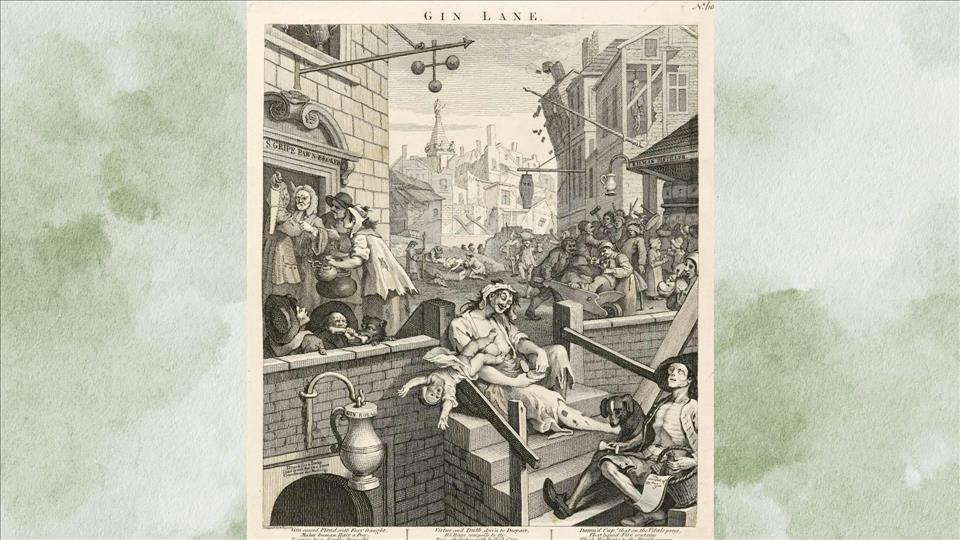Gin Lane By William Hogarth Is A Critique Of 18Th-Century London's Growing Funeral Trade
At the heart of the image, Hogarth depicted a series of steps on which different characters illustrated the gin drinker's descent from propriety to death. At the top of the steps, residents deposited their goods with the prosperous pawnbroker, including a carpenter who handed over his saw – a reminder that gin disrupts industry.
Just below on the steps is a drunken mother whose eagerness to take a pinch of snuff causes her baby to slip from her arms to its death below. The drunken mother is the most striking aspect of Hogarth's image, a focal point that represents how gin detaches the drinker from their closest bonds and duties. Beneath the mother, reclines an emaciated gin drinker whose skeletal features hint at his imminent death. He even lacks the strength to hold his gin glass.

This article is part of Rethinking the Classics . The stories in this series offer insightful new ways to think about and interpret classic books, films and artworks. This is the canon – with a twist.
Gin Lane was one of two contrasting Hogarth visions of life in England's capital in which the fortunes of Londoners were shaped by the drinks they consumed. The inhabitants of the other, Beer Street (1751), are artisans enjoying a foaming tankard during their long day of work.
Beer Street by William Hogarth (1751). Royal Academy of Arts
A blacksmith and paviour (person who lays paving) are in the foreground, while a man tasked with carrying a sedan chair quenches his thirst in the background.
Beer Street is a scene of industriousness in which draughts were consumed without disrupting the effort of the day. High in the scene, a group of workers enjoys beer shared from a jug while a tailor toasts them from a nearby window. The inhabitants' prosperity has just one noticeable consequence in the tattered premises of the pawnbroker.
While Gin Lane can be read as a commentary on the dangers of vice, I believe it also comments on another significant development in 18th-century London – the growth of the funeral trade.
Birth of the undertakerJust above the shoulder of the drunken mother are two coffins. One lies on the ground as a body is placed in it and the other is suspended outside the premises of an undertaker. This latter coffin was a shop sign, which could be seen across the city in the mid- to late-18th century. Undertaking was a developing trade that had many advocates . These undertakers were artisans or traders who supplemented their existing businesses with funerary work.
Undertakers were primarily middlemen who sourced the items required for a funeral, as well as providing items from their own stock. A carpenter acting as undertaker, for example, might build a coffin himself, before turning to ironmongers, drapers and painters for other elements of funerary display.
The supplemental nature of early undertaking enabled many people to adopt the title and some of the most successful eventually specialised fully in funerary work. In the closing decades of the 17th century, the earliest undertakers organised the elaborate funerals of elites, having previously supplied goods for these occasions. As the trade spread, its development was driven by profit and therefore thrived in urban centres where there were more prospective customers.
Detail of the undertaker's shop in Gin Lane by William Hogarth (1751). Royal Academy of Arts
The presence of the undertaker's shop in Hogarth's Gin Lane is a reflection of the trade's increasing popularity beyond the early origins in funerals of the elite.
By the mid-18th century, undertaker-led funerals were a common sight on the city's streets, travelling from bereaved households to parish churches. The upstart trade had drawn criticism as early as 1699 when the author Thomas Tryon argued that undertakers were diminishing the worth of the funerary customs of the elites. And for many critics, there was no group thought less deserving of funerary spectacle than the gin-drinking poor.
Critiquing the undertakerHogarth's inclusion of the undertaker was also a comment on the motives of the developing trade and the worth of its service. In Gin Lane, he emphasised the way that undertakers profited from the misfortune and misery of others.
He places the undertaker's shop at the heart of a ruined street, where other trades have failed and the residents lie incapacitated and dying. His message is clear – the undertaker gains from the loss of others and so is little different from the other thriving businesses of the fictional street, the pawnbroker and the gin shop.
The open coffin and the distant funeral party, detail from Gin Lane by William Hogarth (1751). Royal Academy of Arts
The opened coffin and distant funeral party can also be read as a comment on the worth of the funerary products that underpinned the trade's success. The lidless coffin is presented as little more than a box to contain the half-naked remains of the woman who is lowered into it. And the depiction of the dead woman reminds us that the coffin does nothing for its inhabitant – its purpose is purely aesthetic.
A uniform aesthetic is important to the funerary party, wearing hatbands and mourning cloaks as they wander through the tattered background. Yet the neatly attired procession is lost within the image and fails to hold the attention of the neighbourhood. The cost of these items cannot influence the attitudes of those outside of the funeral. Through these small details, Hogarth reminds the viewer that funerary goods are a hollow expenditure, which cannot improve the circumstances of the dead or the bereaved.
Much as the inhabitants of Gin Lane ruin themselves in pursuit of gin, so might the viewer waste their money on funerary goods that do not serve any practical purpose. As such, Hogarth's work is more than a simple comment on the consequences of the gin craze – it's a wider critique of how 18th-century Londoners spent their money.
Beyond the canonAs part of the Rethinking the Classics series, we're asking our experts to recommend a book or artwork that tackles similar themes to the canonical work in question, but isn't (yet) considered a classic itself. Here is Dan O'Brien's suggestion:
Juan Manuel Echavarría has used photography to document how people experience death in a time of crisis and brutality. His work Réquiem NN (2006-13) uses imagery of graves in a Colombian cemetery to explore how people's treatment of the dead is both an act of dignity and a form of resistance.
A man looks at Requiem NN. Associated Press/Alamy Stock Photo
Réquiem NN depicts graves used for unidentified bodies that have been recovered from Colombia's Magdalena River as a result of civil war. We see each grave in two periods, bringing to life the act of mourning, which has been performed for the unnamed dead, and revealing how the living use the graves to record the names of victims who were their own relatives.
Looking for something good? Cut through the noise with a carefully curated selection of the latest releases, live events and exhibitions, straight to your inbox every fortnight, on Fridays. Sign up here .

Legal Disclaimer:
MENAFN provides the
information “as is” without warranty of any kind. We do not accept
any responsibility or liability for the accuracy, content, images,
videos, licenses, completeness, legality, or reliability of the information
contained in this article. If you have any complaints or copyright
issues related to this article, kindly contact the provider above.
Most popular stories
Market Research

- United States Lubricants Market Growth Opportunities & Share Dynamics 20252033
- Daytrading Publishes New Study On The Dangers Of AI Tools Used By Traders
- Newcastle United Announce Multi-Year Partnership With Bydfi
- Ecosync & Carboncore Launch Full Stages Refi Infrastructure Linking Carbon Credits With Web3
- Utila Triples Valuation In Six Months As Stablecoin Infrastructure Demand Triggers $22M Extension Round
- From Zero To Crypto Hero In 25 Minutes: Changelly Introduces A Free Gamified Crash Course






















Comments
No comment